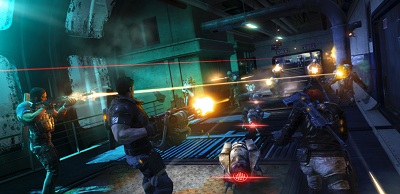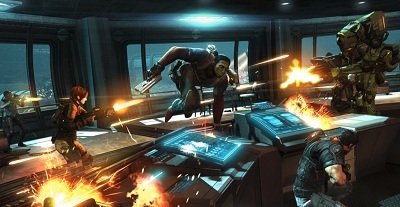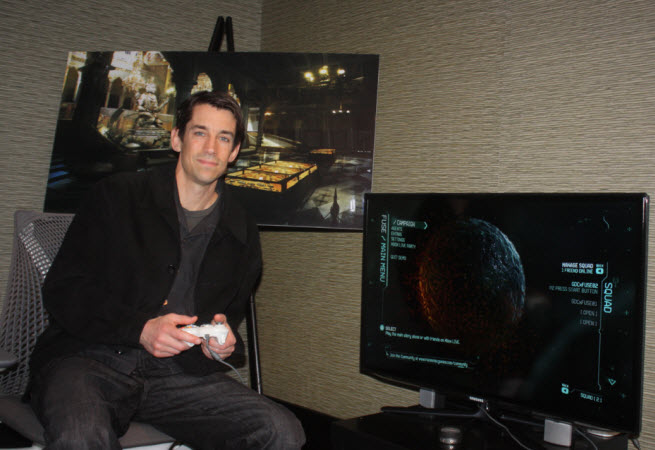Insomniac Games‘ Fuse may be one of the last of its kind when the sci-fi console game debuts in stores in North America on May 28. It’s a new intellectual property, designed for the current-generation game consoles at the end of a cycle. Most game creators are either doing the third or fourth title in a series or moving on to next-generation systems.
But the timing of this shooting riot could turn out to be great for Insomniac and its publisher, Electronic Arts, said Ted Price [above], the chief executive of Insomniac, in an interview with GamesBeat. Instead of being just another sci-fi shooter, Fuse is a four-character co-op title that you can play in a single-player campaign or with three other friends. If it’s a hit, it could generate big sales because the installed base of Xbox 360 and PlayStation consoles is at a peak.
“The key is exposure, making sure that people understand that the game exists and know what’s different about it,” Price said. “The other aspect of this game is that it’s a very social game. Even though you can play by yourself in the campaign with three bots, it’s a lot of fun playing with friends.”
I saw one of the combat sequences of the game last week at the Game Developers Conference, with Price serving as my co-op partner in a battle on the Xbox 360 console. The scene started out in the second level of the game, where an elite combat team takes on a paramilitary group in a base in the South China Sea. You start out unarmed and in a jail cell. By the end, you’re ripping enemy soldiers to shreds with the power of Fuse, an alien energy source that has spawned a global struggle.
Fuse has high production values, and it brings something new for hardcore gamers who have been getting tired of sequels. In recognition of the new age of digital gaming, the title is Insomniac’s first major cross-platform IP, and the company is making other games for mobile and Facebook platforms as well. Here’s a transcript of our interview with Price.
 GamesBeat: You get to some serious combat pretty early in Fuse.
GamesBeat: You get to some serious combat pretty early in Fuse.
Ted Price: Yeah. That’s the second level of the game. We introduce you to combat relatively gradually in the first level, so that we don’t completely overwhelm you, but the key is that combat’s not easy. All four players have to work together.
GamesBeat: How does the sequence of story and combat alternate here?
Price: We don’t have cinematics every five minutes. It was important for us because we knew there would be groups of people playing the game together. We couldn’t slow the game down too much. There’s a lot of emergent dialogue that helps fill in the backstory, a lot of chatter between the characters. We do have story moments — we’re about to hit one — during the levels to help explain who these additional NPCs are. There are a lot of them inserted into the game. All of them are motivated by Fuse in some different way.
GamesBeat: It was easy to learn, though.
Price: Yeah, you got it. It was great.
GamesBeat: Normally, I’d have to train more to understand what’s going on with this. That was your intent, I guess?
Price: Yeah. We’re pretty fixated on creating intuitive controls. We spent a lot of time on it. That’s often taken for granted because gamers assume that games are going to be well-tuned and easy to play. But that aspect of building games is usually what takes the longest time. You tweak-tweak-tweak until it feels good to fire a weapon or feels good to take cover or feels good to vault. Those are the little tweaks that take us weeks and weeks to get right.
GamesBeat: What’s your postmortem up to this point? [Laughs] I know you’re not quite done, but you’re close.
Price: We’re a new IP coming out at the end of a life cycle. For us, it’s been fascinating because we’re now spending a lot of time educating people on what Fuse is versus having the third sequel in a franchise where people already know the story and the characters. We’re explaining the world and who these characters are. But at the same time, we’re introducing what we believe are some fresh features to the co-op shooter genre.
Leap, for example. Being able to leap back and forth between characters is something we have to actively show people so that they get it. The assumption, usually, is that when you pick your character, you’re locked in. Most games do that these days. It’s fun to play with folks who haven’t played this and show them that feature so that they can start moving back and forth between the characters. That wouldn’t have any value at all unless all four characters were different, though.
The other thing that we’ve been demonstrating a lot is how the class-based archetypes come into play during these big battles. You’ve got Dalton as a tank or Izzy as the healer and crowd control. You were playing Naya as the area-of-effect specialist, but she’s also a great flanker. She can go invisible.
GamesBeat: I forgot to make myself invisible.
Price: [Laughs] Well, that’s OK. That’s cool because you’ve got a lot of opportunities to experiment. Because you can try all four characters and because you’re constantly expanding their skill trees and adding more efficacy to their skill sets, it keeps the game fresh.
 GamesBeat: I’m used to not being powerful at the beginning of a game. This is interesting, to have such devastating options.
GamesBeat: I’m used to not being powerful at the beginning of a game. This is interesting, to have such devastating options.
Price: To be fair, today we leveled you up a lot. We’ve been playing through this demo and earning a lot of skill points and applying them.
GamesBeat: Making it a little bit easier, then.
Price: Yeah. With your warp rifle, you’re able to trigger those black holes there very quickly.
GamesBeat: Business-wise, it almost seems like it’s a good way to launch a game. You’re coming out at the end of a cycle with a very large installed base. There’s no limitation from the installed base on what you can sell at this point.
Price: The key is exposure, making sure that people understand that the game exists and know what’s different about it. The other aspect of this game is that it’s a very social game. Even though you can play by yourself in the campaign with three bots, it’s a lot of fun playing with friends. We are going to be doing more and more to show off the game and explain the social aspects. Hopefully, when people get their hands on it, they’ll start asking their friends to play. That’s what’s fun about co-op games in general. When you get together with your buddies, you make time and you play.
GamesBeat: It’s a little harder with this, maybe. You have to re-explain what the game is about because of the pivots you’ve made.
Price: We didn’t actually explain a whole lot in 2011. We showed a trailer. Then people made a lot of assumptions based on that trailer. Those assumptions, in many people’s minds, became fact even though that wasn’t exactly what the game was about.
GamesBeat: You’re coming out in the middle of a big explosion in digital game releases, that service model. Following that model, you might have gotten that feedback much sooner. It almost seemed like you learned very late in your process that maybe you should switch to something else. Do you feel like that at all?
Price: That’s what people assume. Because we’ve been working on the game from the beginning, we know just how much changed and how much didn’t change. What didn’t change was the core of the game. The game itself has not changed. Some of the veneer has changed, and that has been what some people have glommed on to versus what actually makes the game fun.
What makes the game fun is the cooperative gameplay, whether you’re playing it by yourself or with other people. This game is built from the ground up as a four-player game — with weapons that complement each other, with weapons that can be overlaid, with [role-playing game] elements that you don’t see in a lot of shooters. That stuff has been in forever. Unfortunately, the best way to demonstrate that is just to have people play the game. We’re now at the point where we are having a lot of people play the game, and it’s great to see their reactions versus just the assumptions people have made based on a couple of trailers.

